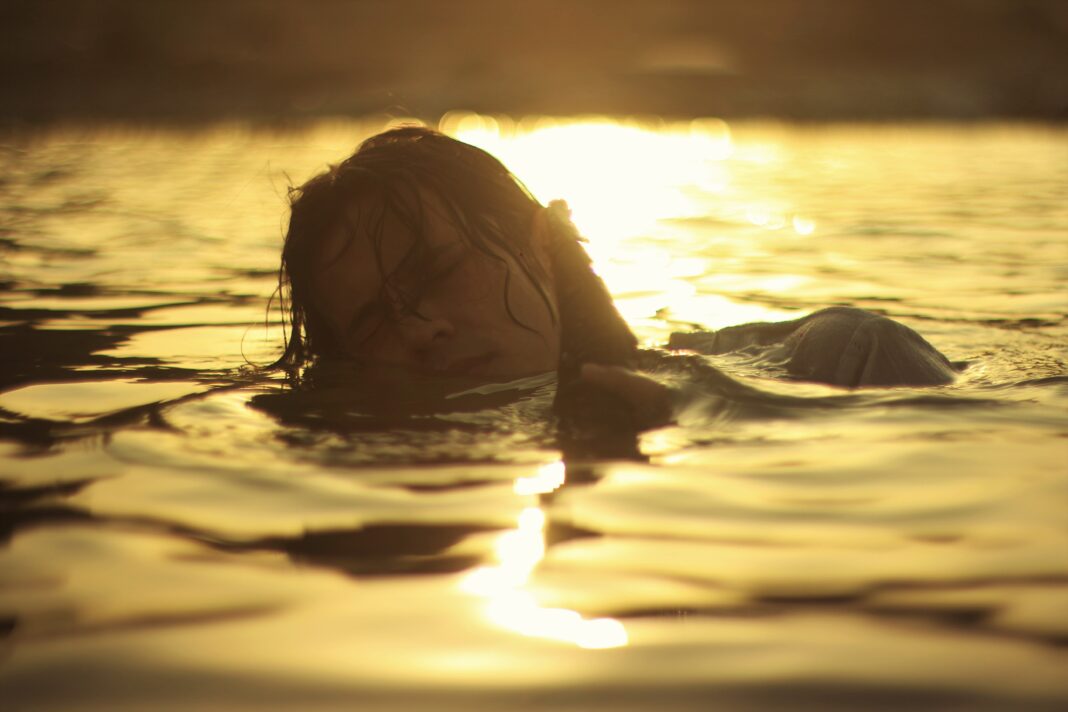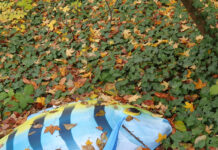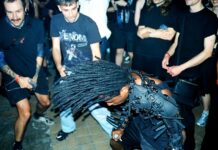
Photo: Press (Ruhail Qaisar)
Every record is an invitation to travel—to foreign lands and cultures, sometimes even through time. This is especially true for Fatima, the debut album by the Ladakhi multi-media artist Ruhail Qaisar for the Swiss-based Danse Noire label. Heavily informed by his home country’s complex geopolitical status—the region has been the source of dispute between India, Pakistan, and China, borders on Tibet and the union territory Jammu and Kashmir—history, society and culture, it’s a multi-faceted album further enriched by the artist’s writing in English, Urdu, and Tibetan as well as photography by an accompanying book. Qaisar will present the album, featuring contributions by Dis Fig and Elvin Brandhi, live at CTM Festival in Berlin in 2023. Ahead of that, he offers some „music for the winter winds“ with his contribution to our Groove podcast.
Your mother was a radio announcer for All India Radio and introduced you to a lot of music early on in your life. What kind of sounds and music styles impacted you when you were growing up and what led you to pursue music more earnestly?
My mother had her tenure as an announcer way before I was born so that didn’t have a direct impact on me, rather much growing up in a house next to a Buddhist cremation ground in an area called Skampari (Dry Mountain), and witnessing a funeral processions, or being taken to see the flagellation and chest-beating at an Ashura at an early age have definitely had the deepest sonic impacts on me.
In your official biography, you emphasise the fact that you are a self-taught artist. What did your first steps in producing music and working with sound look like? Your first instrument was a guitar and you used to play in a death metal band.
I had no clue about music or any semblance of how to play an instrument until very late, neither was it encouraged in my family or generally in society as it is not seen as a practice that will guarantee any kind of financial stability, so the germ of being a musician from Ladakh always seemed like I was approaching a far-fetched fantasy. I had no access to lessons of any kind, my friends taught me some basic guitar but I didn’t even touch the instrument again until years later. I always felt the urgency to borrow instruments and learned with them, at one point after a decade of YouTube circa 2006 to 2016, I was deeply fixated on the sounds of Necrovore and Morbid Angel and I started approaching the guitar by slowing down their fast and complex songs and learning them by ear. Then I formed my death metal band called Vajravarah. We played ultra spastic and psychotic music, like flames fanning a tantric dance. My first steps were reckless in terms of music production, none of the songs or samples on my earlier material had any headroom and I always ended up being in the red, which was undoubtedly due to limitations I had in terms of accessibility to expensive software, and knowledge. However, these perils of trial and error brought forth creativity from another approach. Fruitfully I managed to find ways to improvise and finesse the limitations which trained my mind outside of dry exercises and technical lessons, focusing more on intention and expression. Fatima was entirely produced through Moog synthesizer applications that I had opportunistically purchased for free on Robert Moog’s birthday from the app store, a soundcard, and a basic field recorder.
Sound practice is only one part of your artistic endeavours, you also work across other media like photography and film. How do these different activities tie into each other?
I did always find post-internet age media sterile, so in some search for a sense of warmth and colours, I started approaching analogue photography a few years ago but stopped as it is an expensive medium. What I do appreciate about it is the spectrality and the tangibility this medium holds; also tying into a place like Ladakh and searching for a semblance or a shred of innocence from the past subdued me to work with 5 VHS tapes I recovered from an abandoned storage space at my grandmother’s house. It was bare-boned found footage from 1997 to 1998 out of which I developed a perfect montage, conjoining things that do not belong together. Surprisingly they served as the perfect visual accompaniment to the eerie atmospherics of the music.
Fatima is your first release since 2016’s Ltalam EP under your now-defunct Sister moniker. Thematically, it is inspired by the decades of political turmoil that left its imprint on the social fabric of your home region Ladakh—intergenerational and personal trauma are key subjects in your work. How does all of this influence the music that you are working with?
When it comes to sound, context is key. I was lost searching for context amongst other themes more alien to me for a long time, and what I essentially realised is that I am operating without coordinates. The story of Ladakh has never been brought to the forefront of contemporary music by a local who was born and raised there; either it is received as traditional tokenism of folk song and dance for cultural events, or has to assimilate to the templates of music from mainland India. I wanted to desert these notions and make room for my own expressions. My ideas were focused more on the depopulated spaces, the vastness and the emptiness of the landscape, certain spectres of distant and not-so-distant history, vernacular poetics delving beyond the symbolic into pre-linguistics, the fabric of life enmeshed in mythic structures. I grew up with a deeply idyllic and photographic memory of my community. These 15 to 30 characters, neighbours, friends, and relatives were my hyperbolic world as a child, and to slowly see them being destroyed by illness, conflict, mental health issues, natural calamities or just by their own personal problems, affected me existentially. The Ladakhi people, despite sharing different religious backgrounds, have a strong bond of support among the communities. It is called the Phasphun system, we help each other in joy and despair. Since almost everybody knows everybody else in a town like Leh, a tragedy like death or a disappearance regardless of religious/ethnic background is bound to leave deep and slow lashes on memory, when we mourn, we mourn together unconsciously. Time itself is traumatised, and the history is at times measured in a series of traumatic clusters. To add to that, certain traumas of the past generation carry over to the next, fear being the agent and conduit, and the next generation by this self-propelling mechanism tragically does function on this very basis of fear. Seizures, suicides, flash floods, prolonged disappearances, voids of trauma on personal identity, the invisible gaps in the collective unconscious, the contrast between the chaotic hyper-polluted world of New Delhi and the hypernaturalism from the empty heathlands of greater Ladakh, between monstrous capitalism and ancient mythos, and the dissolvability of identities mediating between these worlds. The creep of life itself, gyrating in the winds as aural hallucinations.
You work a lot with found sounds and field recordings. What is your approach to collecting them and what is most of interest to you when using them for your compositions? Are their contents relevant, or are you guided by aesthetic concerns?
I recently moved very closely to the Indus river and would go for swims almost every day in the summer during the pandemic. On my walks, I would have myriads of encounters with the sonic events that would present themselves to me. Anything from a horse chewing on grass to a calf walking on fresh concrete and the creaking of rusty gates carried very strong sonic traits. I never wanted to embellish these elements with extra effects but rather allow them to take their own space and propel the dramaturgy.
The album and the accompanying photo book are marked by the use of different languages, English as well as Urdu and Tibetan ones. What role does language generally play in your work that otherwise is primarily concerned with sound and vision?
I grew up reading all these languages in my first school in Leh. Whenever I do end up using my own voice in live performances, being trilingual serves the function of glossopoetic vocalisations very well. On the other hand, a language like Urdu is deeply poetic yet simple and my parents don’t understand my complex English, so it started as an exercise to make them read my writings. But the translations brought on another layer of metaphysics to the work. My mother tongue Ladakhi and Tibetan share the same script, Bodyig. There were certain song titles on the album which were in Ladakhi, and I didn’t want to denigrate or butcher the complex phonetics by romanising them entirely. Ladakh, before its very recent orientation as an autonomous union territory of India, was also a frontier district under Kashmir, so the official language used was Urdu, and the struggle of Ladakhis towards autonomy during this period also gave Bodyig a definitive push to be a mandatory subject in the school curriculums, along with Hindi and English, which was already taught. I am a product of this period, and all in all, it felt honest to capture holistically the linguistics of Ladakh.
You’ve just recently celebrated your Germany live premiere at Berlin’s OHM club as part of a Danse Noire showcase. Performing live seems to be quite important to you in general. How does it relate to your compositional or artistic practice more broadly?
Since I do come from a background of playing punk and death metal, to be able to channel energy into a live performance; to allow myself to ride the waves of vulnerability and chaos is integral to the process. Most of the tracks on Fatima have been drawn from live improvisation and then chiseled to their final forms, and by any semblance to find a flow and equilibrium within that is simultaneously ecstatic and rewarding. My most recent performance at Les Urbaines in Lausanne was another exercise in experimentation. I brought together Gottfrid Ahman—ex In Solitude and PÅGÅ—from Uppsala, Sweden, and Michael Anklin—a brilliant percussionist from Biel—as a part of my residency at La Becque in Vevey for a week. We worked on compositions together and prepared a performance piece called „FOUR HYMNS OF CRUELTY,“ an ode to the mythocathartic aspects of Ladakhi processional music. We performed as a trio. These were the first germs of songs I wrote in my mother tongue and probably also the first time this language and its poetics were brought into a contemporary setting. Also, to have such amazing creatives to bounce ideas off from and to meld these two worlds together felt very empowering and entrancing.
You used to run a monthly show called Hounds of Pamir at Hong Kong Community Radio until summer this year, but apparently stopped broadcasting. How did you go about programming these shows, for which you regularly invited guests over, and why was it discontinued?
Hounds of Pamir initially started during the pandemic and the early stages of writing Fatima. I was back in my village in Ladakh and the initial demos and ideas I made for Fatima were broadcast in the earlier episodes. Since HKCR is one of the most important community radios in Asia, I wanted to plant a seed to put Ladakh on the map, since in India the representation always does get eclipsed by Bollywood or popular formats. After the initial run at some point, I was selected for CTM Festival’s Hacklab and that took up a chunk of my time, so I started inviting musicians whom I knew for a long time from a myriad of different scenes. Some of them made mixtapes, some performed live. To be able to create such crossovers based in Ladakh during a time when the world was shut down was beautiful. Eventually, my residency with ProHelvetia began in mid-September 2022, and it was hard to manage programming the show while I was occupied entirely with composing my follow-up and touring, so I put it on a hiatus until I could commit completely to it.
What was the idea behind your mix for our Groove podcast?
This mix has some old gems with a new glint, newer ores with an older shine, some glacial obsidians, fermented magmatic moil, and junkyard scraps. An unreleased track from Fatima, new music from other brilliant artists I met on my tour these past three months, a physiogeographic action in a tunnel with a trumpet, aural saliva from an angel’s mouth, music for cold rooms, for the extinguished heat, for the last dregs of polluted fumes, music for the winter winds.
Stream: Ruhail Qaisar – Groove Podcast 363
01. No Future – Maimed Corpse
02. Reveal – Coin Toss
03. Puce Mary – The Alphabet
04. Ruhail Qaisar – The Fanged Poet (Upcoming)
05. Black Curse – Charnel Rift
06. Mt. Fuyu – Ikaris (Upcoming)
07. Yikii – Light of The Anglerfish
08. Zbigniew Preisner – Van Den Budenmayer
09. Tapiwa Svosve – A Lung in a horn in a horn
10. Pure Shit – Integration
11. PÅGÅ – Eyes of the Sepiolanaes
12. No Future – Alright (Babel of Sighs)
13. The Birthday Party – Dead Joe




